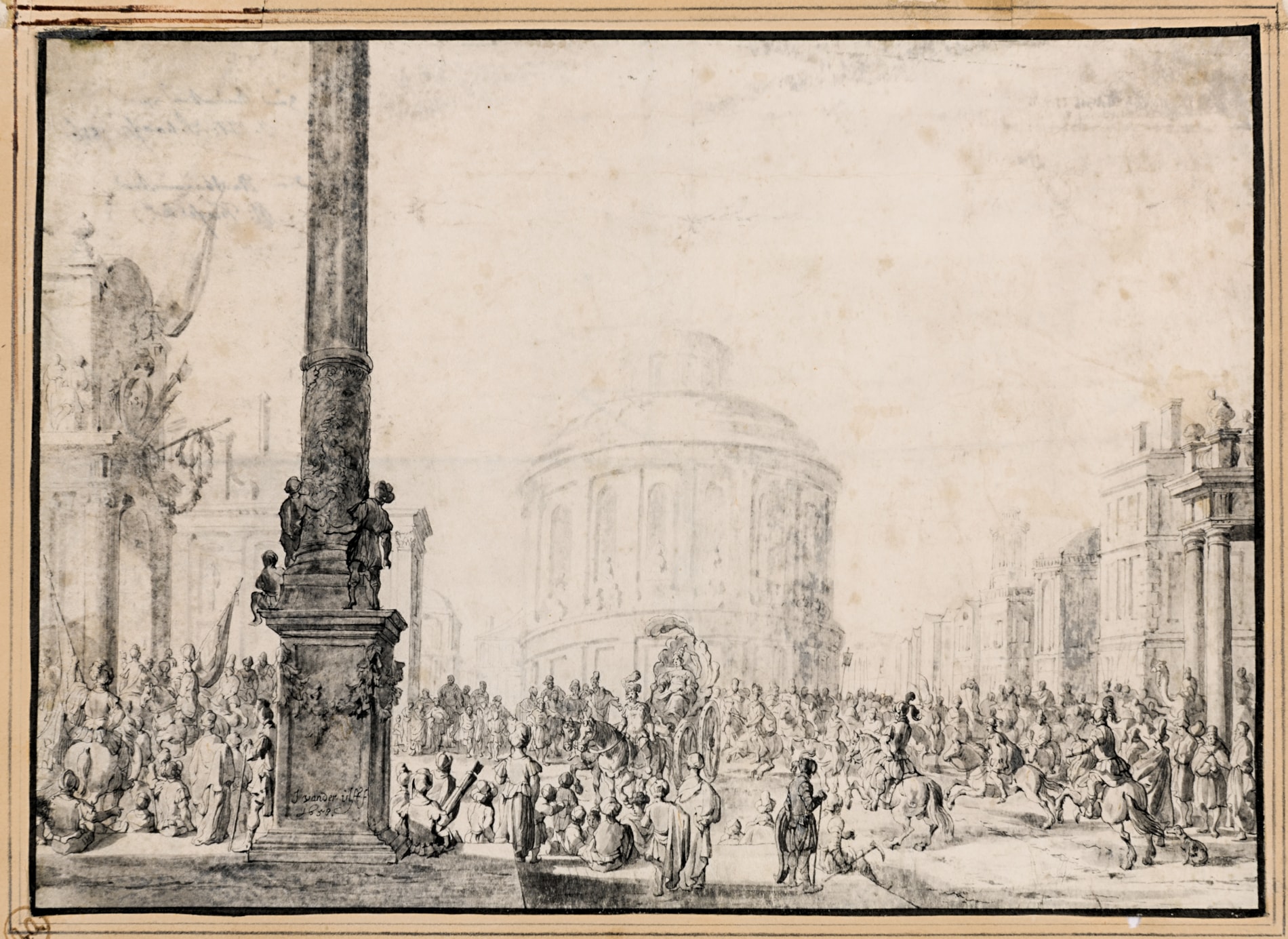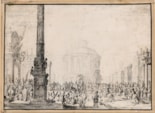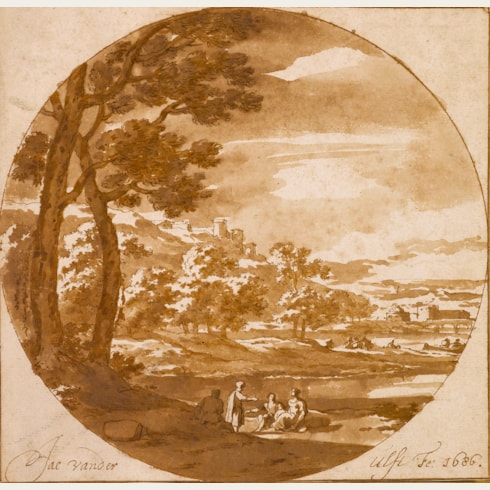Jacob VAN DER ULFT
(Gorinchem 1627 - Noordwijk 1689)
A Procession Before a Circular Temple
Pen and black and grey ink and grey wash.
Signed and dated J vander Ulft f / 1658. at the base of the column near the lower left.
Inscribed on the verso, laid down.
152 x 210 mm. (6 x 8 1/4 in.)
Signed and dated J vander Ulft f / 1658. at the base of the column near the lower left.
Inscribed on the verso, laid down.
152 x 210 mm. (6 x 8 1/4 in.)
An especially refined example of Jacob van der Ulft’s draughtsmanship, this highly finished drawing - prominently signed and dated in full by the artist - was almost certainly intended as an autonomous work of art for sale. As Michiel Plomp has noted, ‘Jacob van der Ulft produced many drawings and paintings of festive processions in imaginary ancient cities...It is not always clear whether Van der Ulft meant to depict actual historical facts.’ A particular comparison may be made with a number of other drawings similarly crowded with figures, including a large drawing of Anthony and Cleopatra in the Louvre and a Procession in an Imaginary Classical City in the Teylers Museum in Haarlem, as well as a drawing of A Roman Street with Figures in the Kupferstichkabinett in Berlin and a drawing of The Flagellation in the Pierpont Morgan Library in New York. Also similar, although somewhat less finished, is a drawing of an Italianate town with a church alongside a round temple or mosque, signed and dated 1666, in the Louvre.
The present sheet bears the collector’s mark of the German editor and publisher Curt Otto (c.1880-1929), who began collecting Old Master drawings around 1908, with a particular focus on Dutch and Flemish drawings of the 17th century. His collection of drawings was dispersed at auction in Leipzig in 1929, the year after his death.
The present sheet bears the collector’s mark of the German editor and publisher Curt Otto (c.1880-1929), who began collecting Old Master drawings around 1908, with a particular focus on Dutch and Flemish drawings of the 17th century. His collection of drawings was dispersed at auction in Leipzig in 1929, the year after his death.
Much of Jacob van der Ulft's surviving painted and drawn oeuvre is made up of Italianate landscapes, or antique Roman cityscapes and port scenes crowded with figures. His drawings - usually executed in pen and ink wash but also occasionally in gouache – are more highly regarded today than his relatively few surviving paintings. Van der Ulft seems to have been an amateur artist and was quite possibly self-taught, as no guild membership is recorded. Furthermore, he is known to have worked as a civil servant in (and at one time mayor of) his native city of Gorinchem. Although there are many quite specific views of Rome by the hand of the artist, many of which are inscribed and dated, it remains unclear whether van der Ulft ever actually visited Italy. The contemporary biographer Arnold Houbraken states definitively that he did not, and claims that his Roman views were based on the work of other artists. Certainly, van der Ulft was profoundly influenced by the work of another amateur artist, Jan de Bisschop (1628-1671), whose drawings approach his own in both style and handling. (It remains unknown, however, whether de Bisschop himself travelled to Rome). An album of forty-three landscape drawings by both Jacob van der Ulft and Jan de Bisschop, mostly views in or around Rome, is in the collection of the Dukes of Devonshire at Chatsworth. Another album of Roman views by van der Ulft is in the Institut Néerlandais (Fondation Custodia) in Paris.
Provenance
C. G. Boerner, Leipzig
Purchased from them in 1920 by Dr. Curt Otto, Leipzig (Lugt 611c), his stamp at the lower left of the old mount
His posthumous sale, Leipzig, C. G. Boerner, 7 November 1929, lot 140 (‘Triumphzug in einer orientalischen Stadt. Links ein Triumphbogen, in der Mitte ein Rundtempel. Höhe: 15 cm. Breite: 21 cm. Feder und Pinsel, in Tusche, auf Pergament. Bezeichnet auf dem Sockel einer Säule links: “J. vander ulft f 1658”. Erworben 1920 bei C. G. Boerner.’).
Purchased from them in 1920 by Dr. Curt Otto, Leipzig (Lugt 611c), his stamp at the lower left of the old mount
His posthumous sale, Leipzig, C. G. Boerner, 7 November 1929, lot 140 (‘Triumphzug in einer orientalischen Stadt. Links ein Triumphbogen, in der Mitte ein Rundtempel. Höhe: 15 cm. Breite: 21 cm. Feder und Pinsel, in Tusche, auf Pergament. Bezeichnet auf dem Sockel einer Säule links: “J. vander ulft f 1658”. Erworben 1920 bei C. G. Boerner.’).





